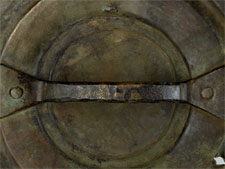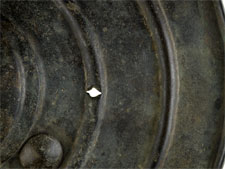
The Wittenham Shield dates from the Later Bronze Age (c.1200-700 BC) and was found in the River Thames to the north of Long Wittenham village.
It is made of sheet bronze with raised ridges and a round boss. The ridges were designed to deflect weapons. The central boss allows the user to hold the handle; shiny wear on the back of the shield and handle shows which way up it was held in the left hand, and that it was well used. Also on the back are two loops used for a suspension chain; the large bosses on the front hide the rivets to attach these.
There are seven examples of this type of shield with raised ridges and a round boss (called Nipperweise); two from Britain, four from Germany and one from Poland.
Most of the British and Irish bronze shields (about thirty-five are known) are decorated with raised bosses rather than ridges. They are made of such thin bronze sheet that they cannot have been used for defence, but must have been for display or only for votive deposition. Most shields would have been made of wood or leather.
Click to enlarge

Wittenham Shield (AN1980.212)
The Wittenham shield is of thick bronze sheet and could have been used in combat (or perhaps as a practice shield). There are three obvious pieces of damage by spearheads; one has worn edges, one was made just before deposition by a socketed spearhead , and the third was made by a point or a spearhead.
All but one of the British Bronze Age shields, as with many other metal objects, are from wet contexts such as bogs, rivers and lakes. They were probably deliberately deposited, perhaps to ensure victory in battle, to placate the gods or to give thanks. Some other shields are damaged, for example pierced by spears or slashed by swords. This may represent the “killing” of the shields before deposition. On the other hand, these objects may have been lost accidentally.
It is not clear how the shield was made. It was either cast in a large mould, or beaten from a single sheet, with the ridges beaten from the back into a mould. Either process needed great skill and the resulting design is beautifully symmetrical. Other large sheet bronze objects such as cauldrons were also produced in the Bronze Age.
The shield is on display in the 'European Prehistory' gallery on the ground floor.

Rear of Wittenham Shield , with handle and spear damage visible (AN1980.212)

Further example of spear damage clearly visible on Wittenham shield (AN1980.212)
Further Information
Find out more about:
- British Bronze Age Collections at the Ashmolean Museum
- The Iron Age sword from nearby Little Wittenham in Oxfordshire
- British Collections Online - searchable database of the collection
Jennifer Forster & Sarah Glover
January 2012